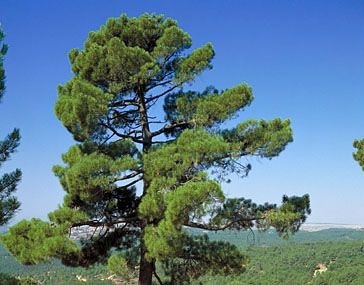
Campus Moncloa
Campus of International Excellence
Genes in pines trees that can be triggered to cope with drought have been identified
Researchers at the Moncloa Campus have discovered the genes in pine trees that can cope with the increasing drought.
09/04/2012
Researchers at the Moncloa Campus have discovered the genes in pine trees that can cope with the increasing drought.
The Universidad Politécnica de Madrid research group of Forest Genetics and Ecophysiology which is part of the Agri-Food and Health and Global Change and New Energies clusters of the CIE Moncloa has studied the genes which can be triggered by inducing drought in pine trees. This research has allowed them to study the molecular tools of these species which cope with water stress.

Pinus pinaster. Source: Ministerio de Agricultura,
Alimentación y Medio Ambiente
The drought we are experiencing this year in Spain has brought the issue of climate change to the forefront. Models have predicted a drastic increase in temperatures, especially in the duration and intensity of drought periods across the Mediterranean basin for the future.
Long-living organisms, such as trees, have to cope with severe alterations of environmental conditions. This situation is especially harsh for vegetation, because the most favorable period for growth in terms of time of light and temperature coincides with the lowest rainfall.
Thereby, the growth process is slowed down or even interrupted and the survival of the plant is put at risk during droughts, especially the first and second year of life. Therefore, Mediterranean species have had to develop a strategy to cope with water shortages.
The current genomic knowledge for gymnosperms is much scarcer than for angiosperms. In general, angiosperms have a very large and complex genome (for example, the Pinus pinaster genome is 10 times longer than the human genome, and 55 times bigger than the popla Populus trichocarpa). In addition, angiosperms and gymnosperms diverged 300 million years ago.
While we know the complete genome of various angiosperm species which include trees, we do not have the complete genome of gymnosperms, and the molecular tools designed for angiosperms are not always transferable to the others.
Researchers have studied the Pinus pinater as a model to carry out a search for genes induced by drought. This is the most common gymnosperm in Spain and was used for reforestation during the twentieth century. To conduct this research, they applied a water stress test under controlled conditions and selected the most expressive genes in comparison to those plants which have not been subjected to stress.
The overexpression of these genes has been tested by using microarray and RT-PCR. The results have recently been published in the journal Plant Physiology and Biochemistry. Among the selected genes we can find transcription factors, elements related to the protection of cell membranes and genes related to the transport and metabolism of sugars, whose accumulation is linked to the increase in desiccation tolerance.
The 67 selected genes will be useful in future research on the response of vegetation at molecular level facing to water stress. Likewise, the analysis of the diversity of these genes and their expression in different species or sources can provide results applicable to the management at a genetic level of pine trees.
Tag: Agri-Food and Health Source: Universidad Politécnica de Madrid
Event date:
09/04/2012
